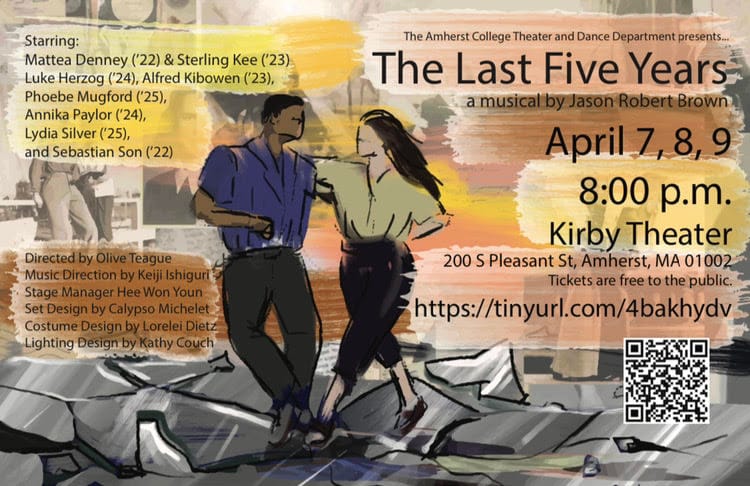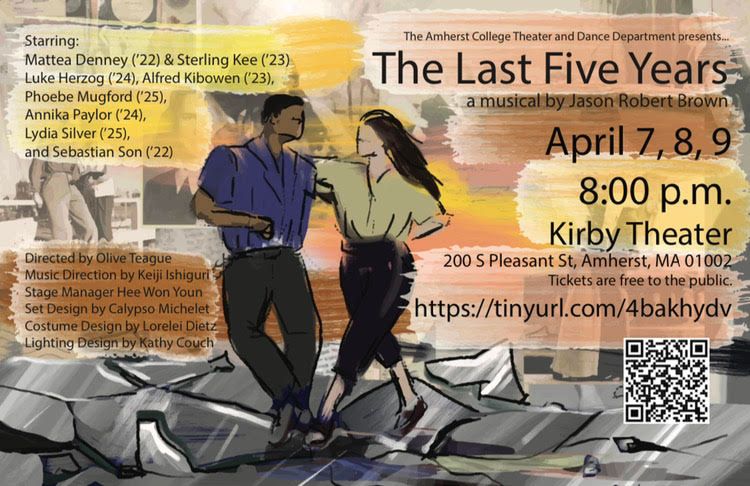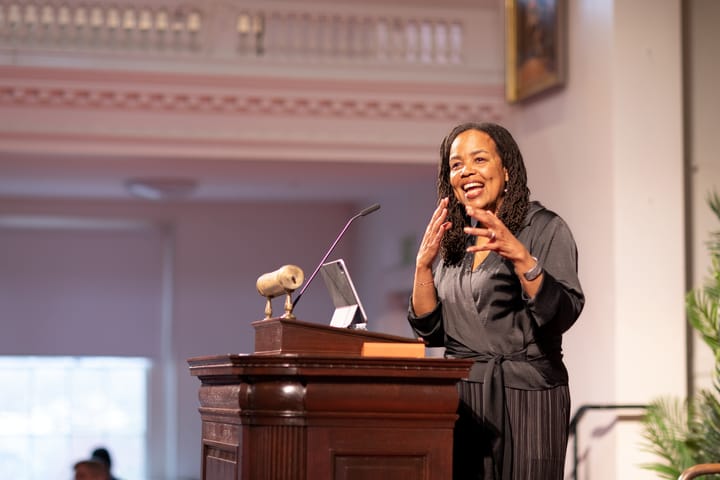“The Last Five Years”: An Innovative and Invigorating Thesis Production
Mattea Denney’s ʼ22 senior thesis was a reproduction of Jason Robert Brown’s musical “The Last Five Years.” Olivia Lynch ʼ25 reviews the play, which featured unconventional storytelling and a talented cast.


This past weekend, Mattea Denney’s ’22 senior thesis production of Jason Robert Brown’s groundbreaking musical, “The Last Five Years,” graced the stage of Kirby Theater. Featuring an expanded cast and innovative staging choices, the production shone with the cast’s creativity and undeniable talent in the face of such demanding storytelling.
In its original form, “The Last Five Years” is a challenging and emotional two-person musical that chronicles the five-year relationship between Cathy Hyatt and Jaimie Wellerstein. The show switches perspective between Cathy and Jaimie in each scene, with Cathy living the story in reverse and Jaimie moving forward chronologically. The characters present each scene independently, only sharing the stage for their wedding in the middle of the show.
“The Last Five Years” has always been one of my favorite musicals. After discovering the film in middle school, I would spend hours on YouTube watching clips from other productions. I love the challenge of its narrative ambiguities, and it takes a talented set of actors to situate the audience in every scene and communicate the complexities of the characters’ love for each other. When I heard about this production — which starred Denney as Cathy and Sterling Kee ’23 as Jaimie — I was particularly excited to see how the musical would change with the addition of an ensemble cast (consisting of Luke Herzog ’24, Phoebe Mugford ’25, Lydia Silver ’25, Sebastian Son ’22, Annika Paylor ’24, and Alfred Kibowen ’23).
The standout star of the production was undoubtedly Denney. From the moment she sang the opening lines of “I’m Still Hurting,” the show’s first and most famous number, I was blown away. Her control of tone sounded professional, and her acting was top-notch. Cathy is a difficult character to play, requiring an actress to express a plethora of complicated emotions all at once. Her songs switch from hopeful to angry to sad all in a matter of seconds. “Climbing Uphill” is a particularly challenging song that requires incredible breath control and range, but Denney’s rendition made it sound effortless.
When I watched Kee’s performance as Jaimie, I thought of the criticism received by Jeremy Jordan, who played Jaimie in the 2015 screen adaptation of the musical. Many saw Jordan’s portrayal as unlikeable and cold — pitfalls that Kee masterfully avoided. While Jordan may have Kee beat with his vocal strength, Kee nailed the characterization of the role. Hearing him sing songs like “Shiksa Goddess” and “A Miracle Would Happen” helped me, a longtime fan, appreciate Jaimie’s character in new ways. In particular, Kee’s use of auditory emphasis highlighted Jaimie’s humor in a way that I hadn’t seen before. While Jordan’s Jaimie was cruel, Kee’s was sincere and funny.
The addition of cast members also improved the show’s entertainment value and storytelling, notably during songs like “A Summer in Ohio” and “The Schmuel Song.” In the former, Mugford, Son, and Kibowen played cast members in Cathy’s summer theater production. Mugford’s performance in particular deserves praise for her creative impression of a snake and exceptionally high kicks.
In “The Schmuel Song,” Herzog took on the role of Schmuel, a fictitious character of Jaimie’s imagination whom he uses to encourage Cathy to pursue her acting career. Herzog’s performance provided a new dimension to the song and proved the strength of the ensemble as an artistic choice.
Beyond the addition of an ensemble, the production made a few other untraditional choices with regard to the show’s staging. In original adaptations, “The Last Five Years” saw Jaimie and Cathy entirely separated during their individual numbers. But in the movie adaptation, director Richard LaGravenese decided to stray from this tradition and include Jaimie and Cathy together in every scene. It seems that Denney’s thesis employed a similar technique. While some scenes starred Kee or Denney alone, many of them saw the two interacting. I think this choice definitely paid off, particularly for songs like “See I’m Smiling” and “If I Didn’t Believe in You.”
The best use of this technique came during “I Can Do Better Than That.” Kee and Denney took center stage, sitting side by side as they simulated a car ride narrated by Denney’s gorgeous voice. Allowing the two to perform this scene together showed off both of their impressive acting and comedic timing skills, and told the story more effectively than if Denney had taken the stage alone.
However, I would note that the challenge of the show’s complex format got the better of the audience, with certain staging choices confusing what was already a difficult narrative structure. When I spoke with friends who had also seen the show, many noted that with limited knowledge about the musical coming in, they struggled to understand what was going on.
Regardless, “The Last Five Years” was a brilliant production full of talented people. Through their performances, the actors communicated the story’s sense of hope and reminded us that, in the words of Denney herself, “there are no happy or sad endings, just new beginnings.”





Comments ()